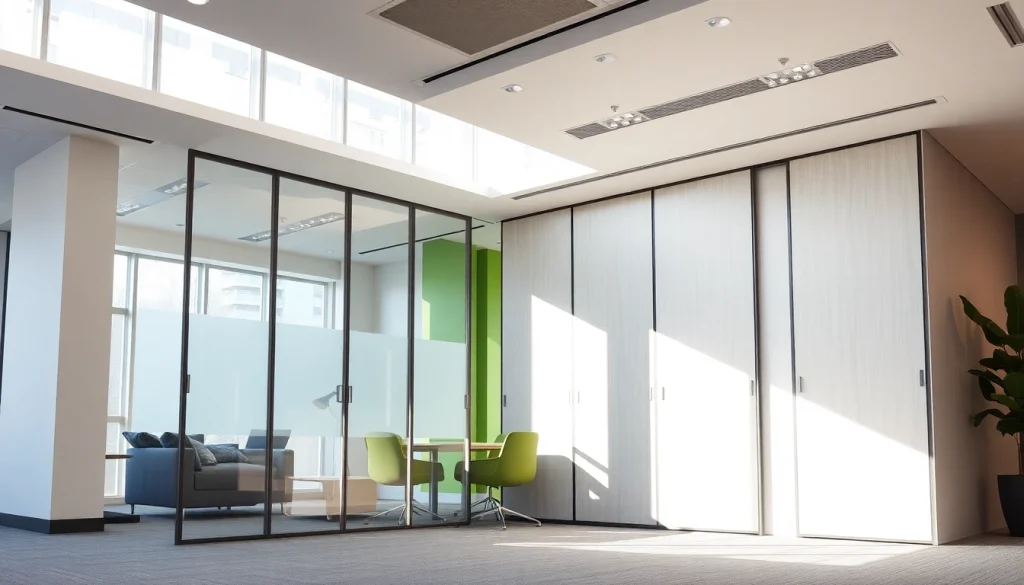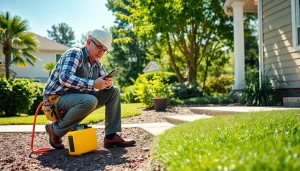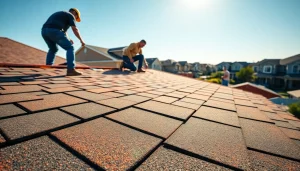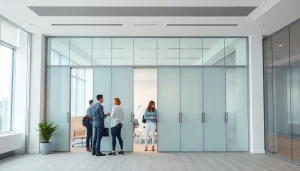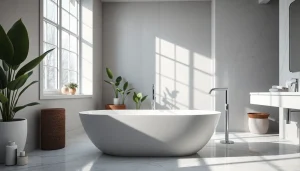Understanding Folding Partition Walls
What are Folding Partition Walls?
Folding partition walls are versatile space management solutions designed to provide flexibility in how rooms and areas are divided or configured. These types of walls can be retractable, allowing for expansive open spaces when needed or closed to create smaller, more intimate areas. They can be made from various materials, such as wood, metal, or fabric, and are commonly used in both residential and commercial settings for purposes ranging from privacy to soundproofing.
Essentially, a folding partition wall functions as a movable barrier that can be adjusted based on the user’s needs. By using advanced engineering and design, these partitions can efficiently adjust space usage without the constraints of traditional fixed walls. For more information on Folding Partition Walls, check out various brands tailored to fit diverse environments.
Benefits of Using Folding Partition Walls
The advantages of incorporating folding partition walls into your space are numerous. Here are some of the most significant benefits:
- Flexibility: Folding partition walls can be easily deployed or retracted based on the use case, allowing spaces to serve different purposes throughout the day.
- Space Optimization: These walls maximize the available area, enabling larger gatherings or more private settings by dividing a room as required.
- Cost-Effective: Compared to constructing permanent walls, folding partitions are a more affordable solution that can be installed without extensive renovations.
- Sound Control: Many folding partition walls offer excellent sound insulation, which is especially important in environments like conference rooms or classrooms where concentration is key.
- Design Aesthetics: Available in various styles and finishes, folding partitions can enhance a space’s appearance while serving functional needs.
Common Applications in Residential and Commercial Spaces
In residential settings, folding partition walls are often utilized to create temporary guest rooms, separate play areas from living spaces, or enclose home offices for privacy. They allow families to adapt their spaces as needs arise without committing to permanent changes.
In commercial environments, folding partitions are prevalent in conference centers, schools, and hospitality venues. They can transform large halls into multiple seminar rooms or breakout areas, thereby maximizing venue utilization. Additionally, companies can employ these walls to create dynamic workspaces that adapt to team sizes and project demands.
Choosing the Right Folding Partition Wall
Material Options for Durability and Aesthetics
The choice of material for a folding partition wall significantly influences its durability, aesthetics, and functional performance. Some commonly used materials include:
- Glass: Provides transparency and openness, ideal for modern spaces that prioritize natural light. Glass partitions can also be treated for soundproofing.
- Wood: Offers warmth and natural beauty, suitable for residential applications or upscale commercial environments.
- Fabric: Flexible and often lightweight, fabric partitions can be used for acoustical purposes and are available in numerous colors and designs.
- Metal: High durability and often used in commercial settings where resilience is needed. Metal folding walls typically provide superior sound control.
Size and Configuration Considerations
When selecting a folding partition wall, it’s essential to assess the size and layout of the space where it will be installed. Considerations include:
- Height and Width: Ensure that the wall can accommodate the structural height and width of your space without creating obstruction or safety issues.
- Storage Options: Some partitions are designed to neatly fold away or retract into a wall pocket. Check that you have adequate space available for storage.
- Configuration: Walls can be configured variously, like straight-line folds or Z-style arrangements. Choose what suits your intended use best.
Acoustic Performance and Sound Control
A crucial consideration for many users is the acoustic performance of folding partition walls. Depending on the materials used and how the partitions are constructed, performance can vary significantly. Factors include:
- Sound Insulation Ratings: Look for walls with a high STC (Sound Transmission Class) rating to minimize noise transfer between spaces.
- Sealing Mechanisms: Ensure that the partition has proper sealing mechanisms to further enhance sound insulation when the walls are closed.
- Design Integration: Consider how the partition integrates with fixtures such as ceilings or floors, which can impact sound transmission.
Installation Guidelines and Best Practices
Step-by-Step Installation Process
Installing a folding partition wall, while feasible for many DIY enthusiasts, often requires professional assistance depending on the complexity. Here’s a basic outline of the installation process:
- Measurement: Start by measuring the space where the partition will be installed, ensuring all dimensions are accurate.
- Preparation: Clear the area of any obstructions and ensure the floor is level where tracks or panels will be installed.
- Track Installation: Secure the top or bottom tracks according to the manufacturer’s instructions, ensuring they are straight and level.
- Panel Installation: Install the panels into the tracks, ensuring any soundproofing measures are properly integrated.
- Testing and Adjustment: Open and close the partitions to test for smooth operation and make adjustments as necessary.
Common Installation Mistakes to Avoid
While installing folding partition walls can be straightforward, mistakes can lead to inefficient performance. Avoid these common pitfalls:
- Inaccurate Measurements: Always double-check measurements to ensure that the partition will fit within the designated space.
- Neglecting Support Structures: Ensure walls are properly supported; failing to do so can lead to installation failure or safety hazards.
- Improper Track Alignment: Monitor levels during installation, as misaligned tracks can lead to operational issues down the line.
Maintaining Your Folding Partition Wall
To ensure the longevity and optimal performance of your folding partition walls, regular maintenance is crucial. Here are key tips:
- Regular Cleaning: Wipe down panels and tracks frequently to prevent dirt buildup, which can hinder movement.
- Lubrication: Apply lubricant on moving parts periodically to maintain ease of operation.
- Inspection: Regularly check for wear and tear; promptly address any issues to avoid more significant repairs.
Enhancing Flexibility in Your Space
Innovative Uses for Folding Partition Walls
Folding partition walls are not merely functional; they can also be employed creatively to enhance the atmosphere and usability of a space. Some innovative applications include:
- Creative Room Layouts: In open concept homes or offices, they can create cozy nooks or collaborative spaces tailored to specific activities.
- Event Spaces: Utilize folding walls to design multipurpose venues that can be adapted for weddings, meetings, and exhibitions.
- Art Integration: Incorporate art or branding on the walls to create an aesthetic element while serving practical purposes.
Combining Folding Partitions with Other Design Elements
Folding partition walls can enhance interior design by merging with other features, contributing to a holistic approach to space management:
- Smart Lighting: Pair partitions with smart lighting systems to create dynamic environments that adjust to the needs of occupants.
- Furniture Arrangement: Cohesively arrange furniture with folding partitions to guide movement and improve functionality.
- Acoustic Treatment: Combine folding walls with acoustic panels to further enhance sound management in busy spaces.
Case Studies: Successful Implementations
Real-world examples provide context for the effectiveness of folding partition walls in both residential and commercial applications:
- Commercial Office: A tech startup incorporated folding walls to create a modern office that transformed open spaces into meeting areas during events while retaining collaboration spaces during regular operations.
- Education Facility: A university used folding partitions in classrooms, allowing instructors to easily accommodate different class sizes with adaptive space without building new walls.
- Hospitality Venue: A boutique hotel utilized folding glass walls to offer stunning views while providing adaptable space for private events or larger gatherings, enhancing guest experiences.
Future Trends in Partition Wall Design
Emerging Technologies in Folding Wall Solutions
As technology advances, developments in folding wall design are also taking shape. Trends include:
- Smart Technology: Future partitions are expected to integrate smart technology to adapt settings automatically, leveraging IoT for real-time adjustments.
- Environmentally Friendly Materials: Innovations will include sustainable materials and eco-friendly manufacturing processes to meet growing environmental standards.
- Enhanced Sound Isolation: Research will likely yield materials with even better acoustic performance, providing ideal solutions for busy environments where noise is a concern.
Sustainability Considerations in Partition Choices
Increasingly, businesses and consumers are prioritizing sustainability in their purchasing decisions. Folding partition walls can be designed with this focus in mind:
- Recycled Materials: Opting for partitions made from recycled materials supports sustainable practices.
- Energy Efficiency: Utilize energy-efficient manufacturing processes that minimize waste and reduce carbon footprints.
- Lifecycle Assessment: Assess products based on lifecycle results, ensuring the entire manufacturing process adheres to sustainable practices.
Predicted Market Trends for Folding Partition Walls
The market for folding partition walls continues to evolve, with several trends expected to shape its trajectory:
- Increased Demand in Residential Applications: As more people work from home, the need for adaptable spaces will rise, boosting the popularity of home office solutions.
- Customizable Options: Customers will lean toward tailored solutions that fit unique specifications, demanding more custom options from manufacturers.
- Integration with Modern Design: Design aesthetics that embrace minimalism and open spaces will push manufacturers to align partitions with these preferences.
